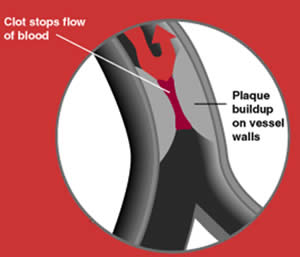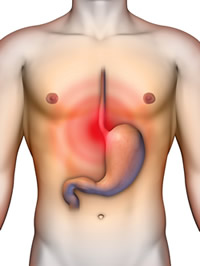Difference between Heart Attack and Heartburn
Key Difference: Heart attack is when the blood flow to the heart is restricted causing the heart cells to die. The lack of blood flow is caused by a partial blockage to the a coronary artery causing the rupture of a vulnerable atherosclerotic plaque, an unstable collection of lipids and white blood cells in the wall of an artery. Heartburn is a condition in which a person experiences a burning sensation or pain in the chest or just behind the breastbone. This burning sensation is caused by acid reflux or when the digestive acid flows up into the esophagus. The acid irritates the esophagus lining causing irritation and uneasiness to the person.
This might seem a silly comparison to cover as almost everyone knows what a heart attack and what heartburn is. However, heart attack symptoms vary between men and women. The symptoms of heart attack in women are very similar to the symptoms of heartburn. This causes many women to not seek medical care when they have a heart attack, believing it to be just plain heartburn. Heart attack and heartburn are two very different conditions and should be taken very seriously. Heart attack has to do with constricting of the arteries, while heartburn is not even associated with the heart, rather with the stomach.
 Heart attack is when the blood flow to the heart is restricted causing the heart cells to die. The lack of blood flow is caused by a partial blockage to the a coronary artery causing the rupture of a vulnerable atherosclerotic plaque, an unstable collection of lipids and white blood cells in the wall of an artery. Heart attack is also known as Myocardial infarction (MI) or acute myocardial infarction (AMI). The reduced blood flow results in restricted oxygen supply to the heart, which manifests itself as severe pain and discomfort in the chest. This pain can then spread to the shoulders, arms, neck, jaw, or back.
Heart attack is when the blood flow to the heart is restricted causing the heart cells to die. The lack of blood flow is caused by a partial blockage to the a coronary artery causing the rupture of a vulnerable atherosclerotic plaque, an unstable collection of lipids and white blood cells in the wall of an artery. Heart attack is also known as Myocardial infarction (MI) or acute myocardial infarction (AMI). The reduced blood flow results in restricted oxygen supply to the heart, which manifests itself as severe pain and discomfort in the chest. This pain can then spread to the shoulders, arms, neck, jaw, or back.
Let’s simplify what happens during a heart attack. Plague made up of calcium, proteins and inflammatory cells cover the lining of the arteries, where they are deposited when the blood flows to the heart. The plague lining becomes hard after constant deposition and then cracks. The ruptured plague gets built up in the arteries blocking the blood from going through to the heart valves. The oxygenated blood never reaches the heart, causing the heart to become starved. This is similar to when a person not being able to get oxygen or air. The cells that do not receive the oxygen start to die. Note: This is permanent damage; the cells do not automatically rejuvenate. The dying of the cells manifests itself as pain and discomfort in the chest. Another reason for a heart attack could be a severe spasm or tightening of a coronary artery. The spasm cuts off blood flow through the artery, which leads to an attack. These spasms can occur in coronary arteries that do not have plaque built up.
Symptoms of a heart attack include: Discomfort (chest, arm, below the breastbone, back, jaw, throat and/or arm), pressure, heaviness, pain (chest, arms and/or below the breastbone), sweating, nausea, vomiting, shortness of breath, irregular heartbeats. During a heart attack, the symptoms last 30 minutes. Some people may also have a heart attack without any symptoms; these are known as ‘silent’ heart attacks and are common in diabetic patients.
 Heartburn is a condition in which a person experiences a burning sensation or pain in the chest or just behind the breastbone. This burning sensation is caused by acid reflux or when the digestive acid flows up into the esophagus. The acid irritates the esophagus lining causing irritation and uneasiness to the person. Heartburn is also known as pyrosis, cardialgia, or acid indigestion. When a person eats food, the stomach is similar to a one way valve, which opens when food is supposed to go into the stomach. This valve keeps the stomach acid from flowing upwards and irritating the other organs. However, certain foods, medications, nicotine or lying down too quickly after a meal and excess weight, can cause the muscle that acts a blocking valve to relax. The relaxation causes the valve to open and allows the digestive acid to flow upward, causing heartburn.
Heartburn is a condition in which a person experiences a burning sensation or pain in the chest or just behind the breastbone. This burning sensation is caused by acid reflux or when the digestive acid flows up into the esophagus. The acid irritates the esophagus lining causing irritation and uneasiness to the person. Heartburn is also known as pyrosis, cardialgia, or acid indigestion. When a person eats food, the stomach is similar to a one way valve, which opens when food is supposed to go into the stomach. This valve keeps the stomach acid from flowing upwards and irritating the other organs. However, certain foods, medications, nicotine or lying down too quickly after a meal and excess weight, can cause the muscle that acts a blocking valve to relax. The relaxation causes the valve to open and allows the digestive acid to flow upward, causing heartburn.
Heartburn is common and can occur as frequently has once a week for some people. However, any more than one per week can point to a much serious disease known as gastroesophageal reflux disease or GERD. GERD is a chronic disease where acid constantly flow from the stomach to the lower esophagus, thus burning the esophagus. Long-term GERD can result in Barrett's esophagus. Barrett's esophagus is a condition where the color and composition of the esophagus change due to constant exposure to digestive acid. Barrett’s can in-turn cause esophageal cancer. Heartburn can also be caused by other conditions such as inflamed stomach lining, peptic ulcer or a hiatal hernia.
Symptoms of heartburn include: burning feeling (in the chest or behind the breast bone), chest pain, burning in the throat, hot-sour or acidic taste in the back of the throat, difficulty swallowing, feeling of sickness or nausea, feeling of food sticking in the middle of chest or throat, coughing, sore throat, etc. Other rare symptoms include pain in the back, jaw, shoulders, neck or arms.
Image Courtesy: skepticalraptor.com, articles.washingtonpost.com









Add new comment